
Silverton is a statutory town that is the county seat, the most populous community, and the only incorporated municipality in San Juan County, Colorado, United States. The town is located in a remote part of the western San Juan Mountains, a range of the Rocky Mountains. The first mining claims were made in mountains above the Silverton in 1860, near the end of the Colorado Gold Rush and when the land was still controlled by the Utes. Silverton was established shortly after the Utes ceded the region in the 1873 Brunot Agreement, and the town boomed from silver mining until the Panic of 1893 led to a collapse of the silver market, and boomed again from gold mining until the recession caused by the Panic of 1907. The entire town is included as a federally designated National Historic Landmark District, the Silverton Historic District.

Silverton is a city in Marion County, Oregon, United States. The city is situated along the 45th parallel about 12 miles (19 km) northeast of Salem, in the eastern margins of the broad alluvial plain of the Willamette Valley. The city is named after Silver Creek, which flows through the town from Silver Falls into the Pudding River, and thence into the Willamette River. The community of Milford was founded in 1846 with a sawmill, store and several other buildings two miles upstream from the present location of Silverton. In about 1853 a second sawmill was built on Silver Creek near where the Silverton city hall now stands. In 1854 the town of Silverton was platted and registered with Marion County. Human habitation of the Silverton area extends back approximately 6,000 years before the present. In historical times, the region was dominated by the Kalapuya and Molala peoples, whose seasonal burns of the area made it plow-ready and attractive to early 19th century Euro-American settlers. Farming was Silverton's first major industry, and has been a dominant land-use activity in and around Silverton since the mid-19th century.
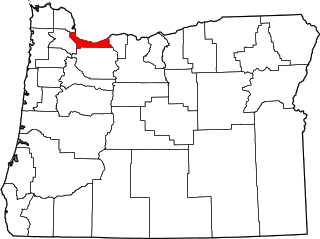
The following list presents the full set of National Register of Historic Places listings in Multnomah County, Oregon. However, please see separate articles for listings in each of Portland's six quadrants.

Silver Falls State Park is a state park in the U.S. state of Oregon, located near Silverton, about 20 miles (32 km) east-southeast of Salem. It is the largest state park in Oregon with an area of more than 9,000 acres (36 km2), and it includes more than 24 miles (39 km) of walking trails, 14 miles (23 km) of horse trails, and a 4-mile (6.4 km) bike path. Its 8.7-mile (14.0 km) Canyon Trail/Trail of Ten Falls runs along the banks of Silver Creek and by ten waterfalls, from which the park received its name. Four of the ten falls have an amphitheater-like surrounding that allows the trail to pass behind the flow of the falls. The Silver Falls State Park Concession Building Area and the Silver Creek Youth Camp-Silver Falls State Park are separately listed on the U.S. National Register of Historic Places.
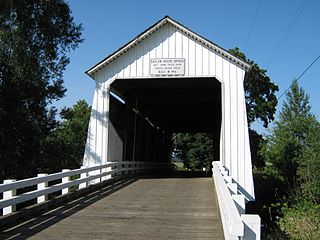
Gallon House Bridge is a wooden covered bridge spanning Abiqua Creek in rural Marion County, Oregon, United States, built in 1916. The 84-foot-long (26 m) bridge derived its name during prohibition when it was a meeting place for bootleggers and moonshiners. The bridge was swept off its footings in the December 1964 flood, but was restored immediately after. Gallon House Bridge is about 2 miles (3 km) north-northwest of the city of Silverton west of Oregon Route 214 on Gallon House Road.

Bobbie the Wonder Dog (1921–1927) was a dog who is acclaimed of walking 2,551 miles (4,105 km) on his own to return home to Silverton, Oregon, United States, after he was lost while his owners were visiting family in Wolcott, Indiana. Ripley's Believe It or Not! estimated the journey may have been as long as 3,000 miles (4,800 km).
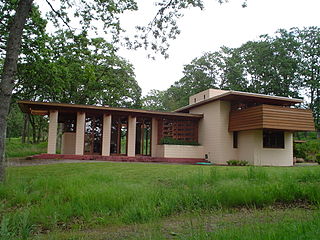
The Gordon House is a residence designed by influential architect Frank Lloyd Wright, now located within the Oregon Garden, in Silverton, Oregon. It is an example of Wright's Usonian vision for America. It is one of the last of the Usonian series that Wright designed as affordable housing for American working class consumers, which—in 1939—were considered to have an annual income of $5,000–6,000. The house is based on a design for a modern home commissioned by Life magazine in 1938.
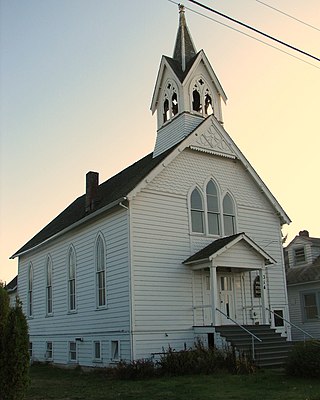
Calvary Lutheran Church and Parsonage is a historic church building and parsonage in Silverton, Oregon, United States. The church is also known as the First Christian Church. The church is a combination of the Carpenter Gothic and the Queen Anne architectural styles. The parsonage is Bungalow/Craftsman and Greek Revival style.

The Nathaniel West Buildings in southeast Portland, Oregon, United States, are listed on the National Register of Historic Places. The two structures are part of a group of three, including West's Block, built by West in the late 19th century.

The Murton E. and Lillian DeGuire House is a historic house built in 1906 and located in Silverton in Marion County, Oregon. It was built in the "Free - Classic Queen Anne" style with modest ornamentation that includes leaded glass, projecting bays, groups of windows that include both long and short windows, and differing siding textures. The basic block form with dormers and gables is perhaps most commonly associated with the Colonial Revival Style.
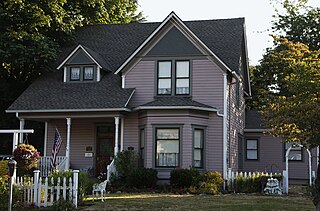
The June D Drake House is a historic house located in Silverton, Marion County, Oregon. It was listed on the National Register of Historic Places on March 12, 2011.

The George W. and Hetty A. Bowers House is a historic residence located in the Kerns neighborhood of Portland, Oregon, United States. The finest of only three poured-concrete houses in Portland, this 1910 residence was built at the height of the short-lived national trend of experimentation with this building method. Although the method largely died out soon after and especially never gained popularity in Portland, this house was at the cutting edge in its time.
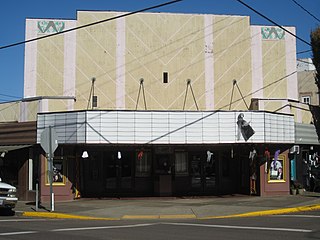
The Palace Theatre is an art deco theatre in Silverton, Oregon, United States. The venue is a contributing property of the NRHP-listed Silverton Commercial Historic District. Stu Rasmussen has been a co-owner since 1974.















